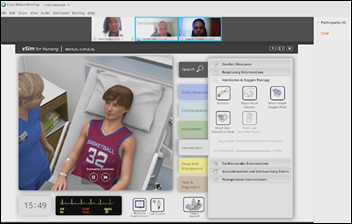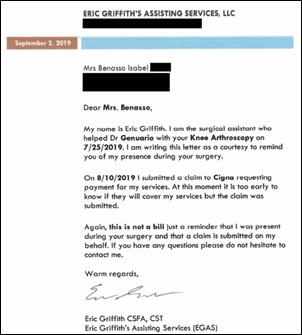Monday Morning Update 8/3/20
Top News
From the Allscripts earnings call, following the posting Q2 results that sent shares up 19% on Friday:
- The $365 million sales price of EPSi to Strata Decision Technology represents 7.5 times trailing 12-month revenue at 18.5 times adjusted EBITDA.
- The company sold no new Sunrise systems, although some existing customers extended their agreements.
- Allscripts will migrate the 450-clinician US Department of State medical units to a cloud-based version of TouchWorks and FollowMyHealth.
- CarePort is managing 40% of post-acute transitions in the US, with 18 million referrals per year.
- Allscripts says that while lower patient volumes and the DoJ settlement caused Q2 revenue to drop year over year, those headwinds will have smaller impact going forward.
- The company says that while it isn’t actively considering selling other parts of “the portfolio,” its data analysis and care coordination systems do more business outside the Allscripts EHR customer base and could stand on their own.
- Pressed by an analyst who observed that the company boosted its quarterly margin by cutting R&D to a level lower than that of competitors such as Epic, Allscripts says it moved work to its offshore employees and downsized its project management offices.
Reader Comments

From Anita Bath: “Re: HIMSS21. Odd that they still haven’t tweeted out that the date has changed.” I didn’t see any mentions on their so-called news site or HIMSS.org (except they’ve added it to the “Events” page) and no actual announcement was made on the conference website, which contains a mix of HIMSS20 and HIMSS21 references. Urgency is minimal since we’re a year away, but let’s hope communication and transparency improves compared to how the cancellation was mishandled. My primary PR advice would be to explain the often-repeated claim that the HIMSS contract prohibits it from offering refunds to attendees and exhibitors – why would HIMSS sign that, and with whom? (my interpretation is that the contract doesn’t require it to provide refunds, which is a vastly different issue). I’m not getting my $895 registration fee back regardless, so given that sunk cost and the fact that I would rather visit Baghdad than Las Vegas in the similar August weather, I will evaluate all over again whether it’s worth it. HIMSS has a big job in trying to drum up the bandwagon effect that makes HIMSS21 seem like a can’t-miss event, which is challenging because we will have already missed it for 30 months and ROI was questionable even before the unexpected contemplation period. And of course there’s the possibility that our coronavirus mess will still be keeping people home even a year from now, especially those from the entire rest of the world that has handled it better, and Las Vegas visitors will probably find COVID to be an exception to the “what happens in Vegas stays in Vegas” mantra for bad behavior. The HIMSS21 floor plan shows 1,249 booths booked by about 350 vendors so far, including the usual big footprints of Cerner, Epic, Allscripts, EClinicalWorks, InterSystems, and Change Healthcare.
From Nick Rails: “Re: HIMSS. They have a long dry spell until August 2021, when the next bolus of revenue comes in.” I’m pretty sure exhibitor and attendee count will be down a lot, and some of those who show up will be applying credits for money they gave HIMSS years before. I expect all member organizations (especially the majority that, unlike HIMSS, gave full refunds for their cancelled conferences) to downsize while simultaneously strong-arming vendors to spend more money to offset those losses. That could create a downward spiral wherein the provider members (the “ladies” in the “ladies drink free” model of attracting those who are willing to pay for access) get so tired of being hit on that they stop coming.
From Long Memory: “Re: Strata. I seem to remember Allscripts suing them at one point over EPSi, which Strata is now acquiring.” Allscripts sued Strata Decision Technology in June 2016, claiming that the company hired former Allscripts Chief Marketing and Strategy Officer Dan Michelson as CEO in 2012 and then used confidential Allscripts information to displace Allscripts-owned EPSi from KLAS’s #1 spot with Strata’s StrataJazz. I don’t know how that lawsuit turned out, but Strata will now own EPSi. Those with long industry memories will recall that Eclipsys acquired EPSi in early 2008 for $53 million in cash.

From Florida Unmasked: “Re: Baptist Health Jacksonville. Over 1,100 beds, signed with Epic last week. Didn’t see it here, so maybe it’s off-the-recordish.” Verified – they signed last week. Epic will displace Cerner.
HIStalk Announcements and Requests

Most poll respondents aren’t worried about career time bombs that are ticking away somewhere online, although it’s interesting that more folks worry about public information than social media posts. Probably because they can control the latter but not the former, which makes Google stalking unchallenging.
New poll to your right or here: Which factor will have the greatest impact on HIMSS21 attendance?
Pondering: why do company executives who boast that they have “right-sized” their business never take the blame for wrong-sizing it in the first place?
Webinars
August 19 (Wednesday) 1:00 ET. “A New Approach to Normalizing Data.” Sponsor: Intelligent Medical Objects. Presenters: Rajiv Haravu, senior product manager, IMO; Denise Stoermer, product manager, IMO. Healthcare organizations manage an ever-increasing abundance of information from multiple systems, but problems with quality, accuracy, and completeness can make analysis unreliable for quality improvement and population health initiatives. The presenters will describe how IMO Precision Normalize improves clinical, quality, and financial decision-making by standardizing inconsistent diagnosis, procedure, medication, and lab data from diverse systems into common, clinically validated terminology.
Previous webinars are on our YouTube channel. Contact Lorre to present your own.
Acquisitions, Funding, Business, and Stock

Meditech reports Q2 results: revenue down 3.4%, EPS $0.88 versus $0.44. Product revenue declined 22%, but net income increased to $33 million.
Exchange-traded funds provider Global X ETFs launches the Global X Telemedicine and Digital Health ETF (EDOC) that will invest in telemedicine, analytics, connected health, and administrative digitization. The top percent holdings among its 40 investments are Ping An Healthcare, M3, Alibaba Health, Nuance, Teladoc Health, Veeva, Tandem Diabetes Care, Dexcom, Agilent Technologies, and Insulet. Also in its portfolio are Livongo, Cerner, Premier, R1 RCM, and Allscripts. I may start tracking the fund’s performance versus market indices, especially if I can set up some kind of portfolio tracker to monitor the share performance of the individual holdings.

Vocera announces Q2 results: revenue up 6%, adjusted EPS $0.10 versus $0.07.

Telemedicine and prescription drug vendor Lemonaid Health raises $33 million in a Series B funding round, increasing its total to $55 million.
People

Bruce Brandes, MBA (Avia) joins Livongo as SVP of directed virtual care.
Announcements and Implementations
Researchers who reviewed TriNetX’s research database found that cancer screenings fell 90% in the first four months of 2020 compared to 2019.
COVID-19
A new CDC projection shows 20,000 more US COVID deaths in the next three weeks, raising the total to 173,000.

Data scientist Youyang Gu, MEng, whose online pandemic tracker has been among the most accurate, believes that the US has passed its peak of cases and expects daily deaths to top out this week. He warns, however, that many states ignore CDC’s reporting guidelines for “probable deaths,” which could skew his model. He expects to see 230,000 US deaths by November 1. Deaths are increasing most in Florida, Texas, and Mississippi, while cases are increasing most in Missouri and Oklahoma.

A YMCA sleepaway camp in north Georgia sees a COVID-19 outbreak in its first few days of operation, with 76% of campers and staff whose test results were reviewed by CDC showing positive. The camp took several precautions, including requiring campers to show proof of negative test results, but did not mandate mask-wearing, housed campers 15 to a cabin, and led groups in singing and cheering.

NPR calls out more problems with HHS’s COVID-19 hospitalization data switchover from CDC’s reliable system to a new $10 million one built by contractor TeleTracking. Hospital-submitted information appears to go live immediately before being QA’ed, sometimes with obvious errors, and HHS has backtracked on its original promise of updates multiple times per day to committing to only a weekly refresh. Hospital capacity information on HHS Protect Public Data Hub was last updated July 23 as I look just now 10 days later. Among several state-level anomalies, NPR found that CDC’s old system showed that 24% of Arizona’s inpatient hospital beds were occupied by COVID-19 patients, but the new system shows 42% occupancy even with 82 fewer patients, and Colorado’s state dashboard lists 341 hospitalized patients on July 30 versus HHS’s 491.
Major League Baseball faces the possibility that its just-started season may end quickly as a second team cancels games after players and staff test positive for COVID-19. Meanwhile, 27-year-old Red Sox pitcher Eduardo Rodriguez, who returned after a “mild” case of COVID, is out for the season due to COVID-caused myocarditis in a reminder that “recovering” from COVID doesn’t necessarily mean a return to previous health.
Recreational boat-owning Americans are sneaking across the border to Canada and turning off their transponders like drug dealers, as locals decry having people from the “biggest Petri dish in the world” going ashore into their otherwise protected communities with no masks or distancing. Eighty percent of Canadians want the border to remain closed to Americans, who are seen as widely ignoring rules of personal responsibility.
Other
Systems of Samaritan Medical Center (ME) remain down from a July 25 malware attack.
Sponsor Updates
- Redox releases a new podcast, “EConsults and Coping with the Year 2020 with Gil Addo of RubiconMD.”
- Customers give Spirion their highest ratings in Gartner’s latest report on enterprise data loss prevention solutions.
- Netsmart lists 16 hospice and palliative care organizations that recently signed for its EHR.
Blog Posts
- My internship at Nuance in the wake of COVID-19: uncertainty and satisfaction (Nuance)
- Texting Consumers is Smart Business Strategy (OptimizeRx)
- How Virtual Waiting Rooms Protect Patients, Staff, and Productivity (PerfectServe)
- MIPS 2020 – What’s New? (PMD)
- Uncover the Hidden Pharmacy Supply Expenses (Premier)
- Pure Accelerates Hospital’s Recovery from Ransomware Attack (Pure Storage)
- Challenges of Remote Patient Monitoring Technology: When and How to Use SMS Texts and Phone Calls for Patients (CareSignal)
- Maximizing Outcomes in the Post-Acute Care Space (Relatient)
- How the Stress Test That is 2020 Taught Me to Lead with Intention (SailPoint)
- Why scalability is crucial to reducing your sensitive data exposure (Spirion)
- U.S. News announces the 2020-21 best hospitals, all rely on Spok (Spok)
- Telehealth technology: from scramble to strategy (StayWell)
- Marketers, Clinicians, and Care Managers in the Patient 360° Ecosystem (SymphonyRM)
- System Administration Appreciation Day – Celebrating Heroes Supporting Heroes (Vocera)
- Using Google Maps and Business Messages to Attract More New PT Patients (WebPT)
Contacts
Mr. H, Lorre, Jenn, Dr. Jayne.
Get HIStalk updates.
Send news or rumors.
Contact us.






































































Anything related to defense will need to go to Genesis.